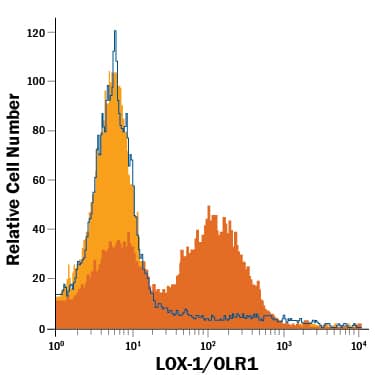Human LOX-1/OLR1 PerCP-conjugated Antibody
R&D Systems, part of Bio-Techne | Catalog # FAB1798C


Key Product Details
Validated by
Species Reactivity
Applications
Label
Antibody Source
Product Specifications
Immunogen
Ser61-Gln273
Accession # P78380
Specificity
Clonality
Host
Isotype
Scientific Data Images for Human LOX-1/OLR1 PerCP-conjugated Antibody
Detection of LOX‑1/OLR1 in THP‑1 Human Cell Line by Flow Cytometry.
THP-1 human acute monocytic leukemia cell line, resting (open histogram) or treated with 50 ng/mL of PMA for 3 days (filled histogram, dark orange), was stained with Mouse Anti-Human LOX-1/OLR1 PerCP-conjugated Monoclonal Antibody (Catalog # FAB1798C) or isotype control antibody (Catalog # IC0041C; filled histogram, light orange). View our protocol for Staining Membrane-associated Proteins.Applications for Human LOX-1/OLR1 PerCP-conjugated Antibody
Flow Cytometry
Sample: THP‑1 human acute monocytic leukemia cell line, resting and treated with 50 ng/mL of PMA
Reviewed Applications
Read 1 review rated 5 using FAB1798C in the following applications:
Formulation, Preparation, and Storage
Purification
Formulation
Shipping
Stability & Storage
Background: LOX-1/OLR1
Lectin-like oxidized low-density-lipoprotein receptor-1 (LOX-1), also known as oxidized low-density-lipoprotein receptor-1 (OLR-1), is a 40-50 kDa type II transmembrane receptor belonging to the C-type lectin family (1). It also belongs to the functionally defined Scavenger Receptor (SR) superfamily, whose members share the common ability to bind and internalize modified forms of Low Density Lipoproteins (LDL) (2-4). LOX-1 is a founding member of the class E scavenger receptor subfamily (SR-E). It binds and supports the internalization of multiple structurally unrelated macromolecules including oxidized LDL, advanced glycation end products (AGE), activated platelets, bacteria, apoptotic or aged cells, and heat shock proteins (5-7). LOX-1 has also been implicated as an intestinal receptor involved in the transcytosis of pancreatic bile salt-dependent lipase (8). The human LOX-1 gene encodes a 273 amino acid (aa) residue protein with a short N-terminal intracellular domain, a transmembrane domain, and an extracellular stalk/neck region followed by a C-type lectin-like domain (CTLD) (1, 6). The CTLD, which is required for ligand recognition, contains the six conserved cysteine residues present in all C-type lectins, but lacks the Ca2+-binding residues found in classical C-type lectins. LOX-1 can be detected on activated endothelial cells, vascular smooth muscle cells, macrophages, intestinal cells, and dendritic cells (6-8). The expression of LOX-1 is induced by proinflammatory or proatherogenic stimuli, as well as by oxidized LDL itself and hemodynamic or oxidative stress. Human LOX-1 exists on the cell surface as a covalent homodimer, that can further associate into a non-covalent-linked oligomer (9). Cell surface LOX-1 can also be cleaved by MMPs (such as MMP-1, -2, or -14) to release a soluble 32-34 kDa LOX-1 extracellular domain (10). Binding and endocytosis of oxidized LDL by LOX-1 induces oxidative stress, activates NF kappaB, and upregulates the expression of Monocyte Chemoattractant Protein-1 and matrix metalloproteases (5-9). LOX-1-dependent oxidized LDL uptake also induces apoptosis by inducing the expression of the pro-apoptotic Bax and downregulation of the anti-apoptotic Bcl-2 (11). Oxidized LDL plays a key role in the pathogenesis of atherosclerosis and endothelial dysfunction. Blockade of LOX-1 functions may turn out to be a suitable target for the therapeutic intervention of atherosclerosis. Over amino acids (aa) 61-273, human LOX-1 shares 61% aa sequence identity with mouse LOX-1 (adjusted for a large insert found in the mouse ECD).
References
- Sawamura, T. et al. (1997) Nature 386:73.
- Zani, I.A. et al. (2015) Cells 4:178.
- Platt, N. and S. Gordon (2001) J. Clin. Invest. 108:649.
- Platt, N. and S. Gordon (1998) Chem. Biol. 5:R193.
- Jono, T. et al. (2002) FEBS Lett. 511:170.
- Pirillo, A. et al. (2013) Mediators Inflamm. 2013:152786.
- Delneste, Y. et al. (2002) Immunity 17:353.
- Bruneau, N. et al. (2003) Mol. Biol. Cell 14:2861.
- Xie, Q. et al. (2004) DNA Cell Biol. 23:111.
- Giola, M, et al. (2015) PLoS One 10:e0141270.
- Chen, J. et al. (2003) Circ. Res. 94:370.
Long Name
Alternate Names
Gene Symbol
UniProt
Additional LOX-1/OLR1 Products
Product Documents for Human LOX-1/OLR1 PerCP-conjugated Antibody
Product Specific Notices for Human LOX-1/OLR1 PerCP-conjugated Antibody
For research use only